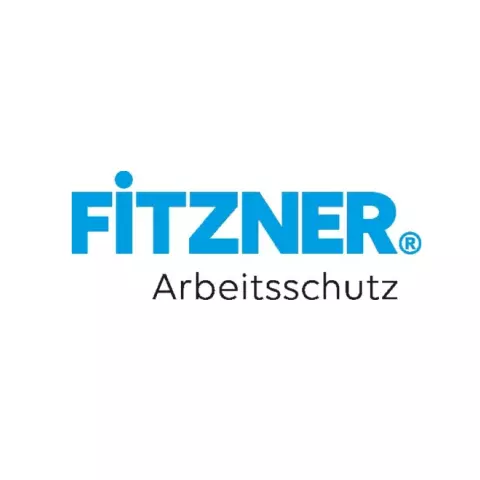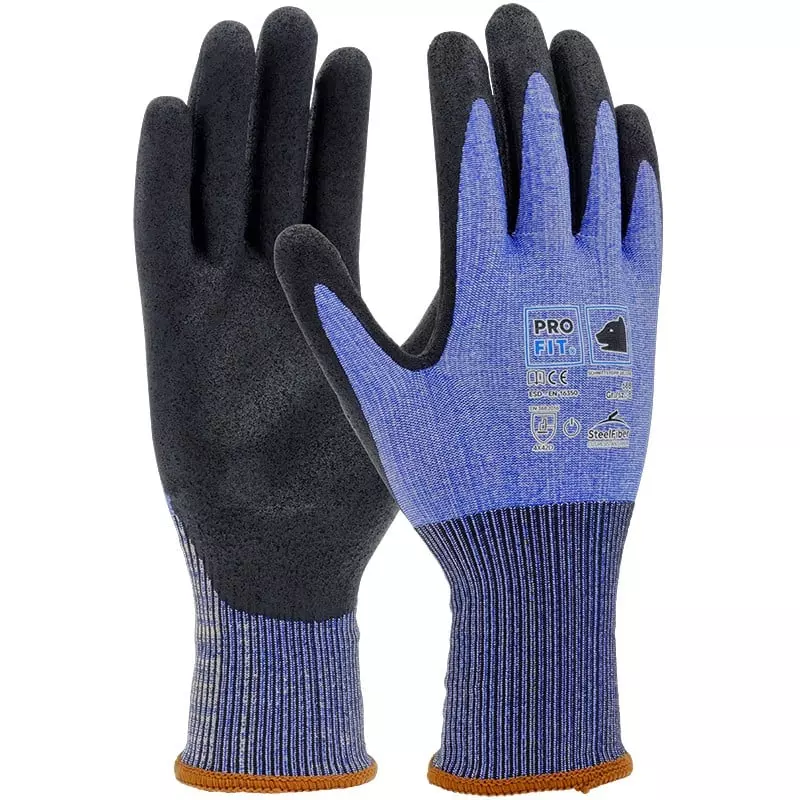PRO FIT Polymer-p Cut Protection Glove
Fitzner Arbeitsschutz
visit storeProduct description
The Prime Cut D cut protection glove combines the highest level D cut protection with excellent freedom of movement through its innovative construction. The combination of HPPE/steel fiber/nylon circular knit and sanded Polymer-P coating ensures optimal protection while maintaining outstanding tactile sensitivity. Thanks to its ESD properties and touchscreen compatibility, it is particularly suitable for use in electronics manufacturing.
Product Features:
- Sanded Polymer-P coating on palm and fingertips
- Seamless HPPE/steel fiber/nylon circular knit
- Patented ultra-thin steel thread for maximum cut protection
- 18 Gauge liner for high wearing comfort
- Touchscreen-compatible coating
Technical Details:
- Cut protection level D
- High abrasion resistance
- Excellent wet and dry grip
- ESD protection according to EN 16350
- Breathable material
Applications:
- Microelectronics
- Precision assembly
- Areas with high cut risks
Standards:
- EN 420:2003 A1:2009
- EN 388:2016
- EN 16350:2014
Indicates the knit density of the glove, affecting dexterity and protection level. Higher numbers offer better finger sensitivity for precision tasks.
Defines how the glove secures at the wrist, affecting comfort, debris protection, and ease of donning/removal. Options vary in security and coverage.
Offers enhanced comfort and dexterity due to the absence of seams. The seamless construction provides a snug fit and reduces irritation during use.
Enables seamless interaction with touch screen devices without removing gloves. Maintains productivity and protection in tech-integrated work settings.
Offers complete hand coverage, including full finger protection from cuts and abrasions. A versatile style suitable for various tasks and environments.
Suited for diverse tasks, offering reliable cut protection without sacrificing dexterity. Balances safety and flexibility for various applications.
Identifies the material applied to the glove's exterior that enhances grip, chemical resistance, and durability while complementing the cut-resistant core material.
- Cut Resistant
- Electrical Protection
- Slip Resistant
- Hand Protection
Request a free sample
Test first and buy later. Visit any product page to request your free sample.
Standards and labels
EN 388:2016 is a European standard for measuring the performance of protective gloves against mechanical risks (abrasion, cut, tear, and puncture). The standard includes test methods and performance requirements for gloves to be considered compliant. Test results are reported using a series of four numbers, each representing the performance level achieved in one of the tests.
Test results
Tear Resistance Level 4EN 388:2016 is a European standard that establishes criteria for assessing the protection provided by gloves against mechanical hazards, including tear resistance. The Tear Resistance Level 4 classification represents the highest level of tear resistance defined by this standard, indicating that the gloves can withstand the most substantial forces before tearing. According to the testing methodology, gloves are evaluated by measuring the force required to tear a sample of the glove material, with Level 4 requiring a force of over 75 Newtons to initiate and propagate a tear. This high level of tear resistance is ideal for use in environments where gloves are subjected to significant stress and potential damage, such as in heavy industry, construction, and handling of materials with sharp edges. Gloves achieving this level offer superior durability and are essential for ensuring user safety in high-risk mechanical settings, thereby enhancing work efficiency and reducing the frequency of glove replacement.
Puncture Resistance Level 2The standard EN 388:2016 includes an assessment of Puncture Resistance, where Level 2 signifies that the material has met specific criteria for resistance against puncture. The result of Level 2 in puncture resistance means that the protective glove or material can withstand a force of 60 to 100 newtons before being punctured. The test method used involves using a standardized steel puncture probe that is pushed against the material at a specified speed until it pierces through it. In essence, achieving a Level 2 puncture resistance under EN 388:2006 suggests that the protective equipment offers moderate protection against punctures, making it suitable for environments where there is a risk of encountering sharp objects such as needles, but are not excessively sharp or exert very high force.
Cut Resistance, ISO 13997 Level DCut Resistance according to the ISO 13997 result under the European Standard EN 388:2016 quantifies the level of resistance a material offers against cutting where the required force to cut through the protective material is between 15 and 21 Newtons. This test method involves applying a straight-edge blade under load over the material's surface and determining the load at which the blade cuts through at a standard length of cut. This stringent testing is critical for products like protective gloves or garments, where high cut resistance ensures better safety and durability in environments where sharp objects are handled. Understanding and adhering to this standard helps procure suitable protective gear that meets safety requirements and offers expected protection for specific risk exposures .
Abrasion Resistance Level 4EN 388:2016 uses a specific test method to measure abrasion resistance of safety gloves; the gloves’ material is subjected to sandpaper under pressure to observe the number of cycles needed to wear through the material. Level 4 in this standard indicates that the material withstood 8,000 cycles before a hole was made. Practically, this means that gloves rated at Level 4 for abrasion resistance offer very high resilience against wearing through, making them suitable for tasks involving significant contact with rough surfaces .
EN 16350:2014 is a European standard that defines the performance requirements for windows and doors in buildings. It covers testing procedures for measuring the safety and security aspects of these products. Test results should show compliance with the standard's requirements, including the resistance to forced entry, load resistance and the ability to open and close easily.
Test results
Electrostatic Properties TestedEN 16350:2014 specifies the test methods and requirements for the electrostatic properties of protective clothing used to avoid incendiary discharges, particularly in environments where there is a risk of explosion. The 'Tested' designation indicates that the material has undergone evaluation to ensure it dissipates electrostatic charges effectively under specific conditions. The standard testing method involves measuring the electrical resistance of the fabric under controlled humidity and temperature conditions to ensure that the material can safely conduct electrical charges away from the body. Protective clothing meeting this standard is essential in industries like petrochemicals, electronics manufacturing, and pharmaceuticals, where static electricity can pose a significant risk of sparking explosions or fires. This certification assures that the clothing provides a necessary level of protection against electrostatic discharge, contributing to the safety and prevention of accidents in hazardous work environments.
CE Marking is a label that shows a product meets certain safety and environmental standards set by the European Union. To get the CE Marking, a company must test and certify their product meets these standards. CE Marking is required for many products sold in the EU, including electronics, machinery, toys and medical devices. It helps ensure that products are safe for consumers and the environment, and allows for easy trade within the EU.
PPE stands for "personal protective equipment." PPE Category 2 refers to equipment that is more complex, and has a higher level of risk. Examples of PPE Category 2 include safety helmets, ear protection, and fall arrest equipment. In Europe, PPE Category 2 must meet certain safety standards set by the European Union, which means that it must be designed and manufactured to protect the user without causing harm. Companies that make or sell PPE must prove that it meets these standards. They also must have a quality management system in place and have to be audited regularly by a notified body.
Fitzner Arbeitsschutz delivery terms
Free delivery when you order more than 1 650,00 kr from Fitzner Arbeitsschutz
Supplier shipping fee 60,00 kr
Brand minimum 1 100,00 kr
852,12 kr
Price per 12 pairs
71,01 kr / pair
Shipping fee is 60,00 kr for orders under 1 650,00 kr
A package contains 12 pairs
Need larger quantities?
Other products you may like
Recently viewed
Need help?
Get help from our experts
Other products you may like
Similar products you may like
Recommended for you
Fitzner Arbeitsschutz
Delivery time: 4 business days
Orders from 1 100,00 €
Supplier shipping fee 60,00 €
Free shipping on orders over 1 650,00 €



Find +150,000 products from hundreds of brands
Autonomous sourcing platform
The most efficient way to source and order supplies for your operations
Sourcing
Ordering
List products you’re looking for and we’ll find the best products and prices for you – all for free.
Need help?
Get help from our experts
